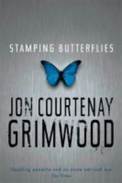In Morocco, in the near future, an apparent madman follows the darkness in his mind and attempts to assassinate a popular and inoffensive US president for no apparent reason. He is captured, unsuccessful, but exhibits baffling behavior in captivity. Somewhere else, in the far future, the latest in a long line of Emperors named Chung Tzu "rules" over the separate plates of a partially assembled Dyson sphere with the aid of the omniscient Library, watched every moment for entertainment by billions of people. And in 1970s Morocco, a native boy befriends a foreign rock star while getting entangled in local politics.
Grimwood's Stamping Butterflies weaves these stories together into a layered plot as complex as the multiple allusions one could draw from the title. Butterflies are a symbol of chaos, flapping their wings to create unforseen events far distant in time and space. Such butterflies can be stamped, created or marked by powers outside human experience, or crushed under the heel of history (and yet still have some effect despite that). They are electric messengers in the dizzingly high-tech world of Chung Tzu, ephemera caught up in the tide of something larger, and also symbols of beauty. And in the garden of the Emperor, they kill those who aren't already ready for their touch.
This is a book that requires attentive reading. Many threads interweave, and the story slips backwards and forwards through time and the lives of the main characters. Paying careful attention to the time given at the beginning of each chapter is recommended or the order of events can get quite confusing. The links between the different stories can also be obscure, and I think I will have to re-read this book before I really understand what was going on. There is an obvious plot (one that's somehow a bit disappointing when it comes together at the end), but there were questions left that I think may have been answered with a more careful reading. Stamping Butterflies isn't at the level of a Gene Wolfe novel, but it's one that requires some work by the reader.
The plot isn't the true star, though. That honor goes to the characters and sense of place. Stamping Butterflies is less about the ripples of history spreading through time and more about the people caught in its wake, particularly the enigmatic assassin known as Prisoner Zero. The heart of the book deals with his mysterious past, his strange and silent behavior, and his unknown reasons for attempting to assassinate the president. Through his calm self-confidence and internal dialogs so at odds with what the rest of the world sees, he becomes the strongest character of a well-developed cast. Grimwood paints his characters with a deft touch, leaving even bit players memorable and none of them feeling like caricatures or stock roles. Just as a small example, the interrogation of Prisoner Zero by the US government is believably disjointed and multifaceted, with equal mixes of torture, lawyers, psychiatrists, and bureaucratic fumbling. (Although I must admit some dubious feelings towards the US president's congenial assortment of advisors.)
Also particularly notable is Grimwood's portrayal of place. Dirty, sun-baked, realistic Morocco and the dreamlike setting of the 2029 worlds are drawn with equal skill. Northern Africa, its poverty, its obsession with foreign tourists and foreign money, and its quietly corrupt politics come alive in Grimwood's hands, even though the book isn't about Africa per se. And as for the partial Dyson Sphere of the far future, it's AI-inhabited technological future crossed with forgotten cyberpunk worlds of outsiders and tradition-based Chinese fantasy worlds reminded me at times of such notable works as Wolfe's Book of the New Sun and Neal Stephenson's The Diamond Age, which is high praise.
I wish more would have been done with the settings and characters, as the resolution of the plot was a bit disappointing. It would have been hard to find a finish that would live up to that setup. Also, as usual with books of this sort, the complexity and obscurity of the connections between the separate narratives were at times frustrating and at times fascinating. A simpler book would not have had the same depth, and yet at times I found myself wishing for a straightforward explanation.
Stamping Butterflies is in some ways more a portrait than a novel, even though it has a plot with a resolution. It paints several cultures and many individuals in beautiful detail, but leaves something to be desired in how it moves them about. Still, recommended. It's good mental exercise, and several of those places and characters are truly memorable.
Reviewed: 2005-10-17
